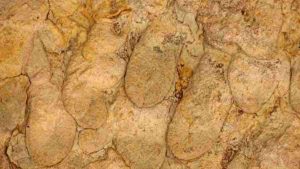
A newly discovered trace fossil of an ancient burrow has been named after University of Alberta paleontologist Murray Gingras. The fossil, discovered by a former graduate student, has an important role to play in gauging how salty ancient bodies of water were, putting together a clearer picture of our planet’s past.
“Naming the fossil after Gingras was a straightforward decision since his research focuses on tying modern observations of how salinity and substrate affect organism burrowing to ancient burrow appearance and species abundance trends.”
Trace fossils are a type of fossil that preserves activity of ancient life in the geological record. They include fossilized footprints, nests, droppings and, in this case, a fossilized burrow dug by an organism that lived in a watery environment.
The fossilized burrow, named Glossifungites gingrasi, is from the late Cretaceous of central Utah and was home to water-dwelling insects, similar to mayflies, more than 90 million years ago.
“Fossils like this are significant because they help us narrow down what type of organism dug the burrow — which in turn will tell us about the salinity of the water in which they lived,” said King.
Many organisms make use of burrows for shelter and protection while they feed. These animal-constructed sedimentary structures give researchers a clearer picture of biological communities and are important in understanding ancient rivers, bays, estuaries and oceans through their oxygenation levels and saltiness, King explained.
Murray Gingras, professor in the Department of Earth and Atmospheric Sciences, was the co-advisor for King’s doctoral studies and for the master’s degree of another researcher on the team, Andrew La Croix, now an assistant professor at the University of Waikato.
“I was surprised and honoured,” said Gingras of the recognition. “I have been recognized with a few different awards over the years, but nothing really came close to the pride and elation I felt when Ryan informed me that he and Andrew formally named a trace fossil for me.”
Reference:
M. Ryan King, Andrew D. La Croix, Terry A. Gates, Paul B. Anderson, Lindsay E. Zanno. Glossifungites gingrasi n. isp., a probable subaqueous insect domicile from the Cretaceous Ferron Sandstone, Utah. Journal of Paleontology, 2021; 1 DOI: 10.1017/jpa.2020.115
Note: The above post is reprinted from materials provided by University of Alberta. Original written by Andrew Lyle.










